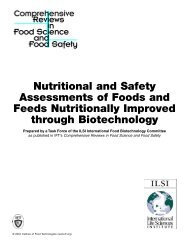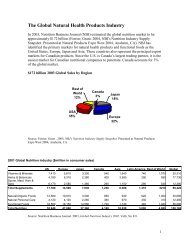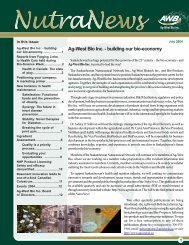Beyond Borders: Global biotechnology report 2010
Beyond Borders: Global biotechnology report 2010
Beyond Borders: Global biotechnology report 2010
You also want an ePaper? Increase the reach of your titles
YUMPU automatically turns print PDFs into web optimized ePapers that Google loves.
total potential value of these transactions<br />
was also relatively unchanged, at €8.7<br />
billion (US$12.1 billion) in 2009 compared<br />
to €8.4 billion (US$11.7 billion) in 2008.<br />
The 2009 total includes the two significant<br />
equity investments made by Johnson &<br />
Johnson, in Crucell and Elan (discussed<br />
earlier). Excluding these transactions,<br />
there were 35 deals with disclosed upfront<br />
payments, which aggregated €710<br />
million (US$990 million), while 2008<br />
saw 40 transactions with an aggregate<br />
value of €610 million (US$851 million).<br />
The average up-front payment disclosed<br />
increased to €20 million (US$27.9 million)<br />
from €16 million (US$22.3 million) in<br />
2008, while the median up-front decreased<br />
to €7 million (US$9.8 million) from €8<br />
million (US$11.2 million). We count 10<br />
transactions with up-front payments of<br />
€20 million (US$27.9 million) or greater<br />
(again excluding the J&J investments<br />
noted above), which comprised 74% of total<br />
up-front payments in 2009. In 2008, there<br />
were 8 such transactions which comprised<br />
68% of total upfont payments.<br />
Canada<br />
While financing for Canadian public<br />
companies fell to a 10-year low, there<br />
was a significant increase in partnering<br />
activities in 2009 — a positive development<br />
for the Canadian industry. For the first<br />
time, there were six licensing agreements<br />
signed by Canadian biotech companies with<br />
potential values in excess of US$100 million<br />
each. The largest licensing agreement<br />
was Cardiome Pharma’s deal with Merck,<br />
whereby Merck acquired exclusive global<br />
rights to an oral formulation of vernakalant<br />
to treat atrial fibrillation. This involved<br />
more than US$60 million in up-front<br />
payments and US$640 million in potential<br />
regulatory and commercial milestones and<br />
royalties. The second-largest deal was the<br />
deal between OncoGenex and Israel’s Teva<br />
Pharmaceuticals for OGX-011, a Phase III<br />
cancer therapy. This transaction involved a<br />
US$60 million initial cash payment, which<br />
was a combination of equity, prepayment<br />
of development costs and up-front fees.<br />
This agreement could result in additional<br />
payments of more than US$370 million for<br />
royalties and milestones. The remainder<br />
of the deals were also interesting, as<br />
up-front payments in all cases exceeded<br />
US$10 million. Canadian companies<br />
did not just out-license assets, however.<br />
Biovail entered into a collaboration and<br />
license agreement with US-based ACADIA<br />
Pharmaceuticals where the company inlicensed<br />
US and Canadian rights to develop<br />
and commercialize primavaserin, a Phase III<br />
drug with a US$30 million up-front payment<br />
and US$160 million in development<br />
milestones, as well as significant royalties.<br />
This agreement also provides for significant<br />
further payments for other indications.<br />
On the M&A front, Montreal-based Nventa<br />
Biopharmaceuticals was acquired by<br />
US-based Akela Pharma in a stock deal<br />
worth C$1.4 million (US$1.2 million).<br />
Australia<br />
With the IPO window closed for Australian<br />
companies, there was some activity in<br />
M&As. Early in 2009, Arana was acquired<br />
by US-based Cephalon for A$319 million<br />
(US$223 million). There was much<br />
speculation that this sizeable acquisition<br />
would lead to a wave of consolidation in<br />
Australia. As it turned out, a number of<br />
small deals followed, but there was only<br />
one other significant acquisition during<br />
the year — the purchase of Peplin by<br />
Denmark-based Leo Pharma for A$318<br />
million (US$207 million).<br />
On the strategic alliance front, the first<br />
quarter of <strong>2010</strong> saw Acrux enter into an<br />
84 <strong>Beyond</strong> borders <strong>Global</strong> <strong>biotechnology</strong> <strong>report</strong> <strong>2010</strong><br />
exclusive worldwide license agreement with<br />
Eli Lilly for its AXIRON male testosterone<br />
product for which its new drug application<br />
is currently undergoing review by the FDA.<br />
This significant deal includes an up-front<br />
payment of US$50 million and other<br />
milestone payments and benefits in excess<br />
of US$280 million.<br />
Other markets<br />
For noteworthy deals in other markets, refer<br />
to the Country profiles section.<br />
Outlook<br />
While there was some slowdown<br />
in transaction activity during<br />
2009 — particularly for M&As — the<br />
challenges motivating these transactions<br />
have not eased. The new normal is<br />
therefore likely to feature an active deal<br />
environment. We expect to see continuing<br />
consolidation of commercial-stage (or nearly<br />
commercial-stage) companies with market<br />
capitalizations under US$10 billion. At the<br />
end of 2009, there were 26 companies<br />
in the US and eight firms in Europe with<br />
a market capitalization of between US$1<br />
billion and US$10 billion. Of these, 26 were<br />
generating revenue from marketed products<br />
and 7 of the remainder had products in<br />
Phase III or awaiting approval.<br />
In addition to strong alliance activity, and<br />
the continued use of options, we can also<br />
expect to see increased use of creative deal<br />
structures as both investors and companies<br />
look to deploy capital efficiently and share<br />
drug development risk. In this regard, we<br />
expect to see companies formed to in-license<br />
pipeline candidates from big pharma and<br />
big biotech companies, with the licensor<br />
retaining an option to reacquire the products<br />
at a later date for a premium — similar to the<br />
Symphony Capital structure that has been so<br />
visible in recent years.








